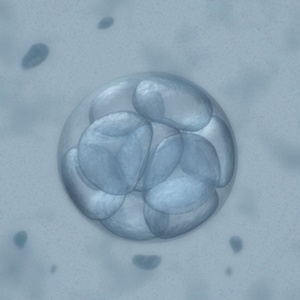
In any IVF cycle, there may be a reason and/or opportunity to cryopreserve (freeze) your embryos. It may be that you have very good–quality embryos and you wish to have the option to freeze and store them for future use. You may be doing a “freeze all” cycle because you would like pre-implantation genetic diagnosis (PGD), or genetic testing, of the embryos, or you may need to do an embryo “freeze-all” because of a sub-optimal uterine lining during your fresh cycle.
Once the embryos have been grown to day 5 or 6 and have developed into viable blastocysts, they are frozen using a process called vitrification. This is a “fast-freezing” protocol that is performed by placing the embryo into a solution and then rapidly plunging it in liquid nitrogen.
This fast-freezing technique increases the cooling rate, thereby preventing harmful formation of ice crystals within the blastocyst that can cause damage and decrease survival rates during the thawing process. It is a far superior method of freezing than the “slow-freeze” method, which tends to have less successful pregnancy and survival rates.
Once the blastocysts are successfully frozen, they are placed on a labeled, sterile straw, with multiple identifiers specific to the patient. The majority of blastocysts are frozen one blastocyst per straw, so that if you only desire a single blastocyst for transfer, they can be thawed one at a time. These straws are then submersed in a securely locked canister filled with liquid nitrogen (they are stored at a temperature of -196 C) and kept locked in the embryology laboratory. Blastocysts can be safely stored in this state for years.
Once you are ready to use the frozen blastocysts, your cycle will be timed so that they are thawed right when you need to use them. They are usually thawed within an hour or so before your actual frozen embryo transfer. Your embryos will be analyzed carefully once thawed to assess viability of the blastocyst and determine if they are viable for transfer. Not all blastocysts may survive the freeze/thaw process, however experienced staff at a qualified fertility clinic will be very selective in choosing blastocysts for freezing, ensuring that the majority will survive and are viable for the frozen embryo transfer. At InVia Fertility Specialists, we see a survival rate of close to 95%.
The next stage is what many IVF patients say is the most anxious and stressful time – the long wait between frozen embryo transfer and the pregnancy test. Hopefully, understanding the embryo freezing process a bit more can help ease some of the anxiety. Because the frozen embryo transfer protocol is slightly easier on the body (less shots, less anxiety with follicle size/egg numbers/embryo development, no retrieval to recover from, etc) most patients say it is a more positive experience than the IVF cycle.
To work with a fertility clinic with a track record of success with embryo freezing, make an appointment at one of InVia's four Chicago area fertility clinics.
Infertility Infertility treatment IVF InVia Fertility Specialists Embryology

Liza has been an embryologist at InVia Fertility Specialists since 2002. She completed her studies, first in animal science at Southern Illinois University, followed by clinical embryology/reproductive genetics at Eastern Virginia Medical School. Her interests include reproductive genetics, fertility preservation, and mitochondrial function in the human oocyte. She loves being a part of helping others achieve and experience the joy of becoming a parent. Seeing the end result .your baby.makes all the hours in the lab worth it!
Subscribe to our weekly blog digest

Entire Website © 2003 - 2020
Karande and Associates d/b/a InVia
Fertility Specialists

Comments